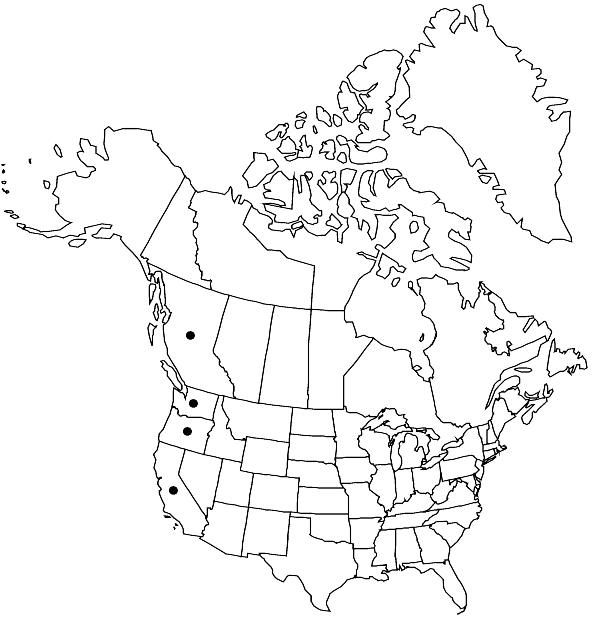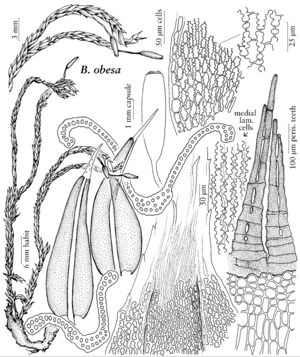Difference between revisions of "Bucklandiella obesa"
in R. Ochyra et al., Cens. Cat. Polish Mosses, 146. 2003,.
FNA>Volume Importer |
imported>Volume Importer |
||
| (6 intermediate revisions by 2 users not shown) | |||
| Line 1: | Line 1: | ||
{{Treatment/ID | {{Treatment/ID | ||
|accepted_name=Bucklandiella obesa | |accepted_name=Bucklandiella obesa | ||
| − | |accepted_authority=(Frisvoll) Bednarek-Ochyra & Ochyra | + | |accepted_authority=(Frisvoll) Bednarek-Ochyra & Ochyra |
|publications={{Treatment/Publication | |publications={{Treatment/Publication | ||
|title=in R. Ochyra et al., Cens. Cat. Polish Mosses, | |title=in R. Ochyra et al., Cens. Cat. Polish Mosses, | ||
|place=146. 2003, | |place=146. 2003, | ||
}} | }} | ||
| − | |basionyms={{Treatment/ID/ | + | |basionyms={{Treatment/ID/Basionym |
|name=Racomitrium obesum | |name=Racomitrium obesum | ||
|authority=Frisvoll | |authority=Frisvoll | ||
| + | |rank=species | ||
| + | |publication_title=Gunneria | ||
| + | |publication_place=59: 117, figs. 29, 30. 1988 | ||
}} | }} | ||
|synonyms= | |synonyms= | ||
| Line 24: | Line 27: | ||
|elevation=moderate to high elevations (600-1800 m) | |elevation=moderate to high elevations (600-1800 m) | ||
|distribution=B.C.;Calif.;Oreg.;Wash. | |distribution=B.C.;Calif.;Oreg.;Wash. | ||
| − | |discussion=<p>Bucklandiella obesa ranges from Vancouver Island to central California at higher elevations. The species is well-defined and distinct from all other congeners by the combination of several structural characters, including strongly modified, hyaline innermost perichaetial leaves, large leaves with a stiff awn, leaf margins that are broadly revolute to recurved to the apex and 2-stratose distally in 2(–3) rows of cells, not differentiated alar cells and basal marginal border, and robust and broad costa, distinctly convex abaxially with 5–9 adaxial cells. It is strikingly more robust than B. heterosticha and B. affinis, the other two species of sect. Laevifoliae that have predominantly 1-stratose and even leaf margins in the distal portion and longer, flexuose, and less spinulose awns. Bucklandiella venusta is easily distinct in its shorter and narrower leaves and much narrower costa as well as in being a much smaller plant. Bucklandiella obesa has often been confused with Codriophorus varius, with which it shares similar robustness and long-cylindrical capsules. However, the latter is readily distinct in its laminal cells that are papillose in a manner characteristic of that genus, much longer peristome teeth, consistently 1-stratose leaf margin, and presence of the pellucid basal marginal border.</p> | + | |discussion=<p><i>Bucklandiella obesa</i> ranges from Vancouver Island to central California at higher elevations. The species is well-defined and distinct from all other congeners by the combination of several structural characters, including strongly modified, hyaline innermost perichaetial leaves, large leaves with a stiff awn, leaf margins that are broadly revolute to recurved to the apex and 2-stratose distally in 2(–3) rows of cells, not differentiated alar cells and basal marginal border, and robust and broad costa, distinctly convex abaxially with 5–9 adaxial cells. It is strikingly more robust than <i>B. heterosticha</i> and <i>B. affinis</i>, the other two species of sect. Laevifoliae that have predominantly 1-stratose and even leaf margins in the distal portion and longer, flexuose, and less spinulose awns. <i>Bucklandiella venusta</i> is easily distinct in its shorter and narrower leaves and much narrower costa as well as in being a much smaller plant. <i>Bucklandiella obesa</i> has often been confused with <i>Codriophorus varius</i>, with which it shares similar robustness and long-cylindrical capsules. However, the latter is readily distinct in its laminal cells that are papillose in a manner characteristic of that genus, much longer peristome teeth, consistently 1-stratose leaf margin, and presence of the pellucid basal marginal border.</p> |
|tables= | |tables= | ||
|references= | |references= | ||
| Line 33: | Line 36: | ||
-->{{#Taxon: | -->{{#Taxon: | ||
name=Bucklandiella obesa | name=Bucklandiella obesa | ||
| − | + | |authority=(Frisvoll) Bednarek-Ochyra & Ochyra | |
| − | |authority=(Frisvoll) Bednarek-Ochyra & Ochyra | ||
|rank=species | |rank=species | ||
|parent rank=section | |parent rank=section | ||
| Line 47: | Line 49: | ||
|publication year= | |publication year= | ||
|special status= | |special status= | ||
| − | |source xml=https:// | + | |source xml=https://bitbucket.org/aafc-mbb/fna-data-curation/src/2e0870ddd59836b60bcf96646a41e87ea5a5943a/coarse_grained_fna_xml/V27/V27_379.xml |
|subfamily=Grimmiaceae subfam. Racomitrioideae | |subfamily=Grimmiaceae subfam. Racomitrioideae | ||
|genus=Bucklandiella | |genus=Bucklandiella | ||
Latest revision as of 21:25, 5 November 2020
Plants large, coarse and rigid, loosely caespitose of forming wide patches, olivaceous to greenish, occasionally somewhat grayish in the upper part, brown proximally. Stems 3–4(–11) cm, ascending to erect, almost unbranched to dichotomously branched, rarely more profusely irregularly branched. Leaves erect to slightly recurved when dry, erect-spreading when moist, stiff, broadly lanceolate, 3–4 × 0.7–1 mm; margins broadly revolute to recurved throughout on both sides, 2(–3)-stratose distally in 2(–3) rows of cells; piliferous, awn short, 0.1–1 mm, stiff, straight or weakly flexuose, faintly or distinctly denticulate and spinulose; costa robust, percurrent, usually broadly canaliculate in mid leaf, strongly convex on the abaxial side, 80–120 µm wide basally and 50–65 µm wide distally, 3–4(–5)-stratose in the basal and median parts with 4–9 not enlarged cells on the adaxial side, elliptical to rectangular in outline in cross-section; laminal cells smooth, 1-stratose; basal lamianl cells long-rectangular to linear, 20–70 × 7–9 µm, porose and nodulose; alar cells not or slightly differentiated; basal marginal border not differentiated; medial and distal laminal cells short-rectangular, 5–25 × 5–9 µm. Inner perichaetial leaves strongly modified, hyaline, membranous, ovate with a short apex. Seta brown, 3–5 mm. Capsule brown, narrowly cylindric, 1.5–2.5 × 0.45–0.5 mm; peristome teeth 400–500 µm, densely papillose, irregularly 2-fid, arising from a low, to 25 µm, basal membrane. Spores 12–17 µm.
Habitat: Dry rocks, stones, boulders, cliffs, rock ledges, rocky ground and soil over rocks, predominantly on acidic substrates, very seldom on limestone
Elevation: moderate to high elevations (600-1800 m)
Distribution

B.C., Calif., Oreg., Wash.
Discussion
Bucklandiella obesa ranges from Vancouver Island to central California at higher elevations. The species is well-defined and distinct from all other congeners by the combination of several structural characters, including strongly modified, hyaline innermost perichaetial leaves, large leaves with a stiff awn, leaf margins that are broadly revolute to recurved to the apex and 2-stratose distally in 2(–3) rows of cells, not differentiated alar cells and basal marginal border, and robust and broad costa, distinctly convex abaxially with 5–9 adaxial cells. It is strikingly more robust than B. heterosticha and B. affinis, the other two species of sect. Laevifoliae that have predominantly 1-stratose and even leaf margins in the distal portion and longer, flexuose, and less spinulose awns. Bucklandiella venusta is easily distinct in its shorter and narrower leaves and much narrower costa as well as in being a much smaller plant. Bucklandiella obesa has often been confused with Codriophorus varius, with which it shares similar robustness and long-cylindrical capsules. However, the latter is readily distinct in its laminal cells that are papillose in a manner characteristic of that genus, much longer peristome teeth, consistently 1-stratose leaf margin, and presence of the pellucid basal marginal border.
Selected References
None.
